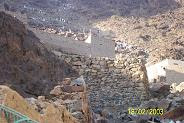The RPG-7
The RPG-7 anti-tank grenade launcher is robust, simple and lethal. It is also extremely popular. As it exists today, the RPG-7 is the result of many years of revisions and modifications. The "original" RPG -- based on the German Panzerfaust anti-tank weapon - was eventually followed by the RPG-2, the RPG-3 and so on. In fact, although the RPG-4 had passed field trials in 1961, test findings of a newer model, the RPG-7, were released that same year, but with much improved firing range and armor piercing capabilities. So in 1961 it was the RPG-7, not the RPG-4, which the Soviet Armed forces adopted for actual use. Today, the RPG-7 is used by the armies of over forty different countries and is also used, reportedly, by a range of terrorist organizations in the Middle East and Latin Americas.Now that we know what an RPG-7 is, let's take a look at how one operates.
 |
Firing an RPG-7
The RPG operator or an artillary assistant takes a propelling charge (booster, in image below) and screws it onto the end of a warhead. Basically, this is a stabilizing pipe that has four stabilizing fins that are folded around it with two additional fins at its rear end. A cardboard container encases the back end of the stabilizing pipe. Inside the cardboard container, a squib of nitroglycerin powder is wrapped around the stabilizing pipe and a primer or charge of gunpowder is stuffed into the end of the stabilizing pipe.
The RPG operator or artillary person then takes this assembled artillery and loads it into the front end of the RPG launcher so that it lines up with the trigger mechanism.
After the RPG operator pulls the trigger, this is what happens:
- A percussion cap ignites the primer, gases build up inside the launcher’s chamber, thereby breaking apart the cardboard container and propelling the grenade forward through the barrel of the launcher. In this way, the cardboard container is a lot like the casing containing the gunpowder on a bullet.

- The force of the built-up gases throws the grenade out of the tube at approximately 384 feet per second (117 meters per second). The abrupt acceleration of the grenade leaving the launcher triggers a piezoelectric fuze that ignites the primer (pyro-retarding gunpowder mixture). This then ignites the squib of nitro, thereby activating the rocket propulsion system (sustainer motor) to carry the grenade the rest of its trajectory.
- As the grenade leaves the launcher, the fins along the stabilizing pipe spread out, which, along with the rocket motor, allow the grenade to travel a long distance at a potential speed of about 965 feet per second (294 meters per second). The grenade moves like a football, rotating through the air; the fins stabilize its flight.

- A socket in the breach block alleviates recoil during firing. The exhaust gases exit to the rear of the launcher unit and the operator is free to immediately reload the weapon. In practice, however, no RPG operator would ever remain stationary and spend the time to reload; the launching flash and whitish blue-gray smoke provides a clear indication to the enemy of the RPG launcher's location. An effective, surviving RPG operator is one who quickly changes position and gets under cover.
There are several types of grenades that can be used in the RPG-7. Some have a point initiating, base-detonating (PIBD) piezoelectric fuze: meaning that they are impact grenades. And, many others have back-up time delay systems, so that if they have not reached a target in a certain amount of time (something like four and a half seconds) the grenade will self destruct. The most commonly launched grenades are a High Explosive(HE) or High Explosive Anti Tank (HEAT) rounds.
Impact grenades must be unarmed until they are actually fired because any accidental contact might set them off. Since they are usually shot from a launcher, they must have an automatic arming system. In some designs, like the one we describe above, the arming system is triggered by the propellant explosion that drives the grenade out of the launcher. In other designs, the grenade's acceleration or rotation during its flight arms the detonator.
As for the back-up timed delay, the same fuze mechanism that sets off the the rocket would set this off. The spark ignites a slow-burning material in the fuze. In about four seconds, the delay material burns all the way through. The end of the delay element is connected to the detonator. The burning material at the end of the delay ignites the material in the detonator, thereby exploding the warhead.
source: science.howstuffworks.com/












No comments:
Post a Comment